All About Radish Seeds
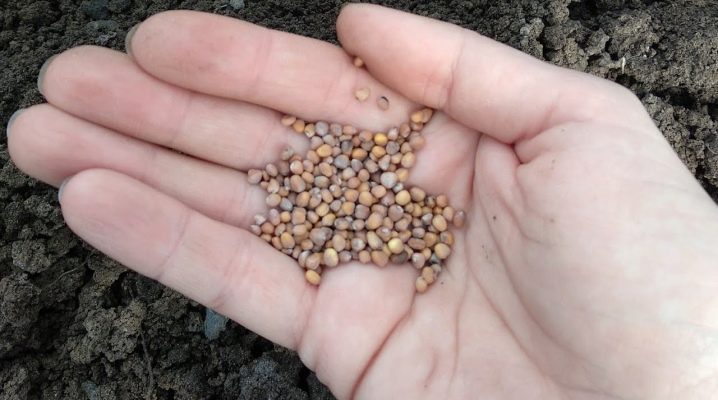
It is impossible to know everything about radish seeds, because in nature there are countless varieties bred by breeders and originators. They have different colors, sizes and ripening times. There are root vegetables that are round, oblong and flattened, sharp or soft in taste, early, medium and late ripening, with colors ranging from red to white. Hybrids have a number of advantages, but retain their properties only in the first generation. Conventional varieties allow you to collect seed at home and get early vitamins immediately after the winter period.
What do they look like?
The description of the seeds certainly begins with the characteristics of a plant, annual or biennial, which belongs to the cabbage family. A delicious root vegetable with a rich content of useful components is grown and eaten in different countries of the world community, therefore, the Japanese, Chinese and European groups are conventionally distinguished. Territorial characteristics do not mean that there are restrictions on cultivation.
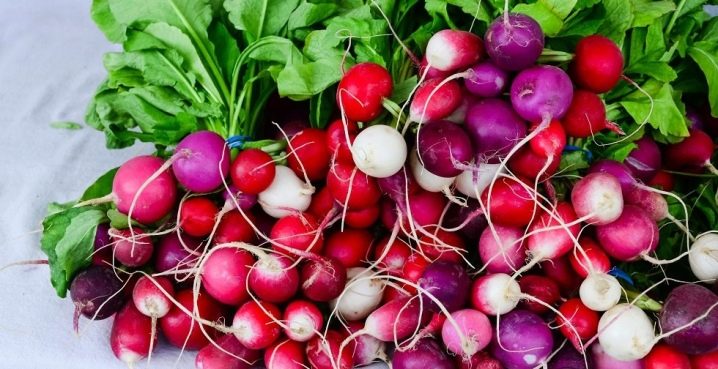
Each gardener chooses a variety for several reasons: ripening time, duration of cultivation, sowing method, shape, color and taste. In addition to the traditional red skin color, you can find white, pink, purple and yellow in the garden. The relatively short ripening time is a great advantage of the root crop. Its complex structure, provided by nature, is aimed at preserving the species and forming seeds. To do this, he has:
- a strong root that goes into the deep layers of the soil to accumulate valuable components;
- a complex structure (except for the root, leaves and a rosette, which are fed from a root crop, a storage organ);
- a flowering shoot that starts immediately after its final maturation;
- flowers that give short pods, which contain small-sized future cruciferous fruits.
Radish seeds are contained in ripe pods no more than 7 cm long. They are described as small brownish, conventionally oval grains. Depending on the variety, they can be light or black, small and slightly larger. The quantity in a pod can be less or more than the declared quantity by 8-10 pieces.
The small size dictates its own nuances of collection at home, storage and planting.

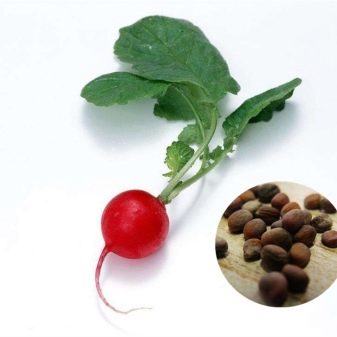
How to grow?
Knowing where the seeds of a popular vegetable come from is not enough to get a high-quality harvest. There are at least three conditions that will help to ensure the germination and preservation of the qualities of the variety you like. And you must definitely remember about them:
- radish should not belong to hybrids (they do not retain parental characteristics and are extremely reluctant to sprout);
- you need to choose from two options for obtaining high-quality seeds (preferably transplant);
- the plant must be isolated from other cruciferous plants, otherwise cross-pollination will occur, and the desired root crop can no longer be obtained.
In the practice of vegetable growers, two methods of obtaining a useful vegetable are common. - with or without plant transplantation. For example, in industrial production, they perfectly manage without moving the mother (selected for collecting seed). This saves costs when it needs to be harvested in large quantities for planting next season.
However, the non-planting method has significant drawbacks - the risk of cross-pollination, prolonged maturation (up to 150 days) of planting material, the inability to select the highest quality mother plants, with guaranteed germination and the preservation of attractive varietal characteristics.
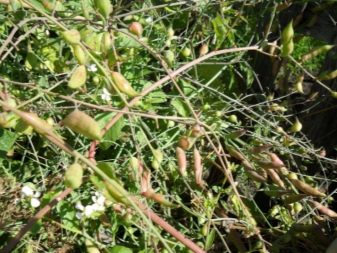
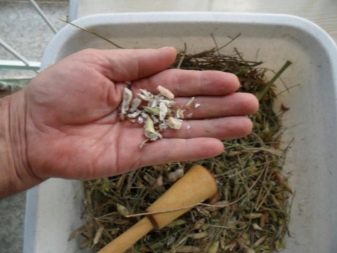
The transplant method is more laborious, but in comparison with the bonuses received, this inconvenience is considered insignificant. It is suitable for gardeners who harvest and occupy the area with another crop, with a later ripening period or before winter, if it is compatible with planting after cruciferous plants.
Sorting through the dug up radish, you can select the most attractive and full-fledged root crops with pronounced properties of the variety (size, texture, shape, strength - these are the main criteria). They are properly prepared for planting. - the foliage is cut, but a short stalk (about 3 cm) is left. Shortened to 4 cm and spine.
Immediately after alerting, the mother radish is planted at a distance of up to half a meter from other specimens. Experienced gardeners say that a good mother plant can provide seeds for a farmer with small planting volumes for several years. The main condition for obtaining benefits is collecting, processing and planting on the same day, otherwise the plant will lose its viability and will not strive to continue the genus.
The bonuses that the hardworking gardener receives are well worth the time and effort. All three obstacles to obtaining home planting material can be avoided: the ripening period is reduced by a month, over-pollination can be prevented and the most suitable mother plants can be selected.
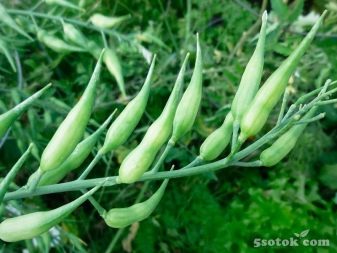
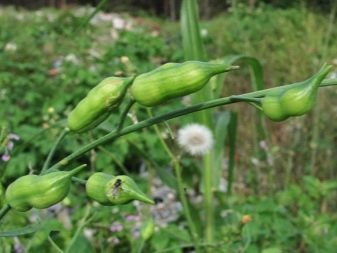
How to assemble?
Watering, weeding, and tying seed plants to small-diameter stumps can make harvesting easier. We must not forget about monitoring for the detection of pests. As soon as a harmful aphid or cruciferous flea is found, insecticide treatment will be required.
The approximate ripening of the pods occurs in early autumn. It is impossible to more accurately determine whether it is in the beginning, middle or end of September - much depends on the variety and timing of the mother liquor transplant. The gardener has a reliable way to find his way - the pods change color. From green they turn into light, brown or yellow shades with a dried texture.
It remains only to cut off the shoot with pods. If there are several of them, tie them into a bunch and dry them in a warm room with minimal humidity and good aeration. For this, a variety of premises are used - from the attic and the shed to the kitchen, loggia or just a glazed balcony.
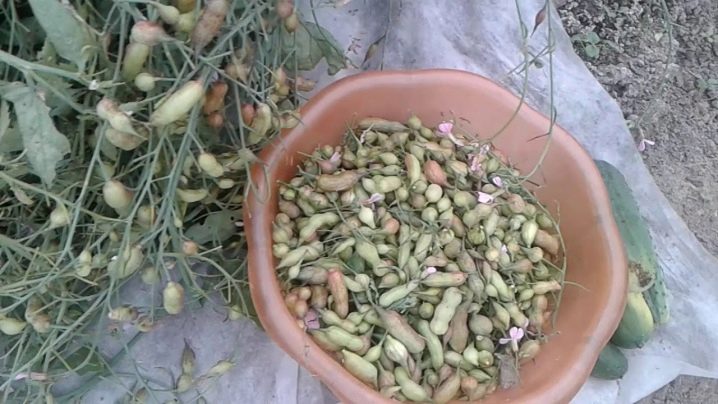
At home, seeds are obtained in a standard, repeatedly tested way:
- the pods are separated from the stems (you can use a pruner for this purpose);
- they are pounded in a deep container until an approximately homogeneous mass is obtained, then carefully poured with water;
- the waste that has floated to the surface is removed, and the water is filtered through gauze;
- they are washed with water and laid out on a suitable surface to dry.
Reviews of gardeners speak about the economy and rationality of home collection.
A little time and expenditure of effort give only from one dry mother liquor the amount that can be obtained by buying 5 bags of seeds (about 20 g) in the store.
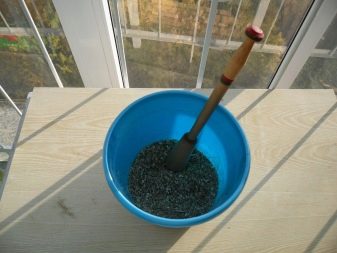
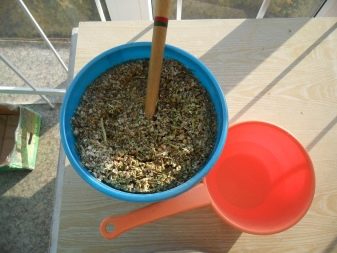
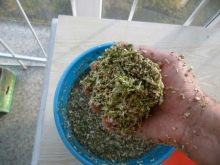

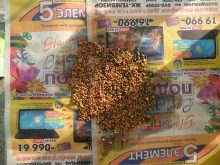
Storage
The shelf life can be increased by carrying out additional processing - after drying the results of the procedure, sort it out, keeping large seeds or let them pass through a stream of air to weed out small debris and seeds that are unsuitable for planting. Future radishes are kept in a natural material - a paper bag, cotton, linen or canvas bag. They are stored in a container for several years, the main thing is not to clog the bag or package to failure, leaving free space for air to penetrate and pouring, to prevent the seeds from crushing and sticking together.
If the result of the activity is a significant amount of seeds, do not get upset and distribute them to neighbors. Germination of radish seeds persists for several years (up to 6-7).
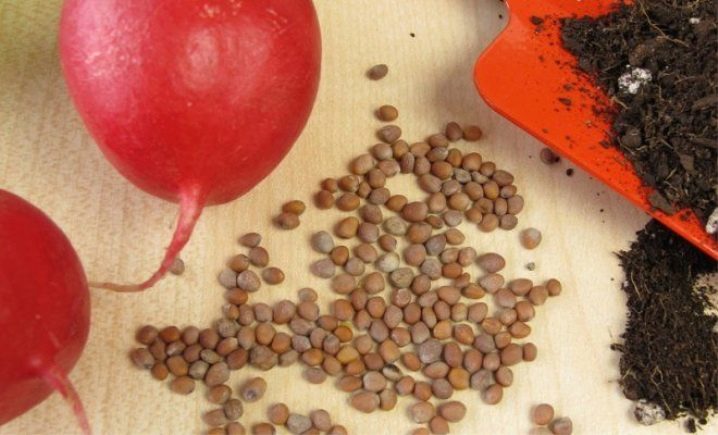
Without the slightest fear, you can sow last year and the year before last. The main thing is to provide them with the right storage conditions:
- the place should be dry and cool (but not cold, frosty air is unacceptable);
- sunlight should not penetrate into it (you can use a cabinet shelf or a closed cardboard box);
- the container is laid out in one row;
- the package or sack must contain the name of the variety and the year in which the seeds were harvested.
Experienced gardeners note that during the first 2-3 years, the seeds retain excellent germination. Their extraction can be done in winter, the main thing is to properly store dry queen cells. The requirement for the container is due to the need for permanent aeration. Polyethylene and other polymeric materials are not suitable for storing any seeds. Storage in a damp or lighted room is unacceptable. Some summer residents use paper envelopes for this that meet all the requirements, do not take up much space and do not create problems with fixing information.
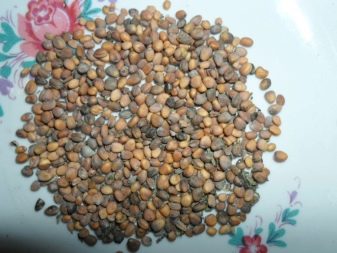
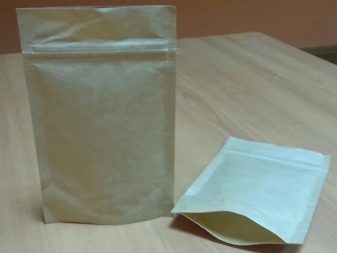
Preparation
Despite the claims that radish seeds retain the ability to germinate for a long time, it is recommended that they be tested for germination without fail. This is a simple procedure that does not require either effort or time. The seeds are laid out on a damp cloth or on a ribbon and kept for 10 days at room temperature. It is enough to calculate how much rose and how much did not respond to heat and moisture in order to solve the problem with suitability for planting. If an insignificant amount has sprung up, then it is time to buy new material or remove containers with a later collection date.
Radishes are planted with dry seeds, soaking for several hours before planting gives a harvest a couple of days earlier, but increases the likelihood of death in case of recurrent cold weather. There is also the opposite point of view from the enthusiasts of this process, who are sure that this is simply necessary.
On the market, you can find solutions with molybdenum, silver, boron or salts that will help increase immunity, survival, protect the plant from fungi, and even stimulate old radish seeds to grow.
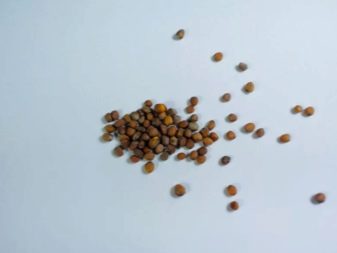










The comment was sent successfully.